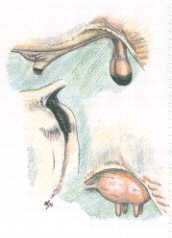Standard of Excellence
Breed Standards
Selection Goals
The purpose of selection as far as the Romagnola breed is concerned is to obtain cattle with a marked capacity to produce beef (significant growth rate, early maturation and yield at slaughter) with excellent eating quality characteristics, while ensuring the ability to adapt to all environments with superior fertility and maternal function.
Bull and Cow Ideal Conformation
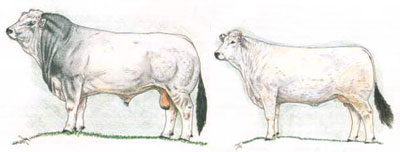
Structure and Type
What is immediately striking about the Romagnola breed is its compact structure, which is due to the balanced development of the animal's trunk featuring notable thickness, and is also related to its well-expressed muscle development and exceptional leg structure. This compactness does not imply coarseness and must be accompanied by a light and distinctive head. Its agile movements and lively yet docile temperament represent additional elements that make it easy to appreciate the functional traits of a breed whose dynamic past can account for its great versatility in adapting even to harsh environments.
COAT - White with shades of grey spread, especially around the eye-sockets, the neck, the thighs and the ears.
PIGMENTATION - Black pigmentation should be seen in the following areas: oral mucosa (mucus membrane in the mouth) , perivulvar (area around the vulva or external lips of vagina) and perianal (around the rectum) area, switch and sheath hair, muzzle, hooves, tips of the horns and base of the scrotum. The persistence of reddish hair exclusively around the poll area (top of the head between the ears), a grey tail and partial depigmentation of the oral mucosa are tolerable in subjects with valuable functional-morphological traits (physical traits that are acceptable in an animal) (This means that a grey tail and partial, or total lack of black pigmentation in the mouth is accepted in animals that are good specimens for breeding in all other desired physical traits).
Hair color is ivory with darker shades of grey that are more intense on the forequarters, especially in bulls. The coat changes appearance depending on the season. During the winter the hair becomes much thicker and darkening in color and conversely during summer the hair gets shorter and lighter. The variation in coat thickness allows the breed to adapt easily to a range of environments and temperatures. Romagnola calves are also born wheat-colored and then turn white at around three months of age. The presence of red hair, particularly on the poll, is only tolerable in young cattle.
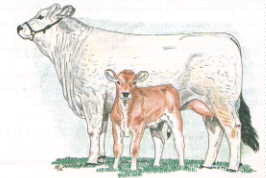
SKIN- Thin, elastic, easy to lift.
HEAD - Distinctive, expressive and light, not overly short; with a straight profile and a flat forehead with a broad muzzle.
Head dimensions must be proportionate to the animal's overall size, must indicate lightness and distinctiveness, showing very evident secondary sexual characteristics. The frontal profile should be straight or slightly concave and the forehead should be wide. The eyes are lively and well hooded within the socket and must have almond-shaped eyelids. The muzzle is wide, with broad cheek muscles. The dewlap must be light around the neck area. Ears are wide and set horizontally, and are extremely mobile.
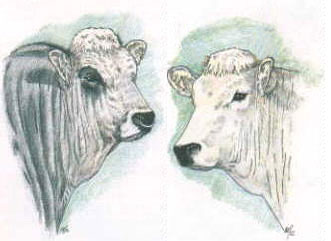
NECK - Muscular and rounded in bulls, muscular in females. Light dewlap.
Powerful and muscular neck, covered with numerous skin folds. The neck is more muscular in males, even at an early age. The dewlap should be light.
SHOULDER - Broad and muscular, set closely to the trunk, parallel to the back line and properly angled.
The shoulder must be wide and should be covered with abundant muscle tissue. It must show harmonious continuity with the adjacent areas. In addition, there must be a proper joint angle between the shoulder blades and the upper leg bones (115-120°).
WITHERS - Broad and muscular.
They must be broad, muscular and flat, in relation with the productive capacity of this breed. This area must show notable muscle development on a general level and must blend harmoniously with the adjacent areas.
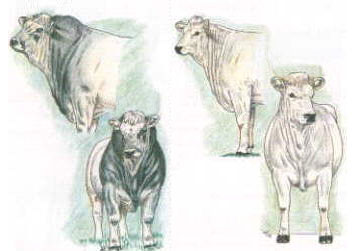
BACK - Straight, long, broad and muscular.
This is an area of fundamental importance, since these muscles yield the highest quality cuts that are the most tender and most valuable. The most important of these is the latissimus dorsi (eye muscle) which contributes to the value of the lumbar region. The back must demonstrate the greatest possible muscle development, to the point of presenting double convexity, blending well into the adjacent areas of the withers and loins without any discontinuity whatsoever.
LOINS - Thick, straight, long, broad and muscular.
In addition to the longissimus dorsi, this region includes other sublumbar muscles that constitute premium cuts such as fillet and sirloin. Like the back, the loins must also be extremely muscular, long and full. The dorsal line must be straight or slightly inclined from front to back (particularly in adult males). This shape indicates excellent structural strength and muscle tone.
CHEST - Broad and muscular.
This feature must be broad and powerful, muscular, sloping and full.
THORAX - Broad and deep, with well-arched ribs and well-covered with muscle mass.
The area has a primary role in determining the development of the rib cage and thus of adequate coronary and pulmonary function. Therefore, it is an important index of constitutional strength. In the Romagnola, the ribs are well arched and set vertically. Thorax height is always greater than the distance from the sternum to the ground.
ABDOMEN - Broad and well-supported.
The modern Romagnola type also involves a volumetric decrease of the abdomen, which must be well supported, making the underline practically straight. Adequate abdominal capacity is found in the increased length of the trunk, which works to the benefit of weight and yield.
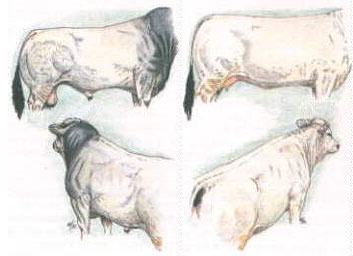
FLANKS - Full well-connected with the adjacent areas.
RUMP - Long, broad and covered with enormous muscle mass; horizontal or slightly inclined from front to back. The sacral vertebrae are not very marked. Slender tail with proper insertion point, descending to the hock.
No compromises are possible as far as the surface and muscle development of the rump are concerned, given the importance of this area in producing premium cuts. The tail area must be flat and the tail must extend at least to the hock. The transverse diameters (pin bones) are pronounced, so that this breed is predisposed to an extremely low rate of calving problems, even at first calving.
THIGH - Deep, broad, muscular and convex.
BUTTOCKS - Thick, muscular and noticeably convex.
These areas, which are of primary importance in beef cattle, are particularly well-developed in Romagnola subjects of both genders. Muscle development, which tends to be short-lined, is compact and has markedly convex profiles in both areas.
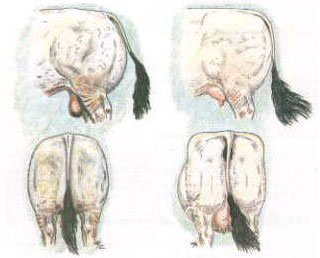
FORELEGS - Proper slope, muscular arms and forearms, solid and light shin.
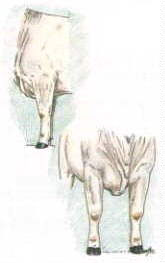
HIND LEGS - Proper slope, very muscular leg, lean strong hocks, solid and light shin.
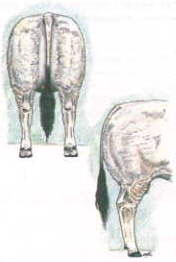
FEET - Strong, very compact, with heels set high.
The Romagnola breed is widely recognized for the strength of its legs and feet. Both the forelegs as well as the hind legs must be lean, with sharp and sturdy joints that exhibit proper slope. The foot is average in size and is properly angled. The horny tissue is well pigmented, strong, compact and the heels are high. Movement should be agile and graceful.
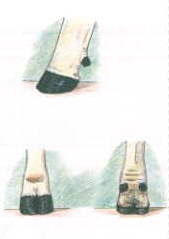
UDDER - Well-developed vascularized and broad-based with even quarters. It should feel spongy with well-directed teats that are suitably sized for suckling.
The Romagnola cow is able to raise its calves until weaning without any problems, even in unfavorable environments. The udder should have a good capacity, with harmoniously developed quarters and properly-sized teats in order to ensure that the calf can be fed without any problems, particularly during the first few days after birth.
TESTICLES - Well-proportioned and developed descendent in the scrotum area.
